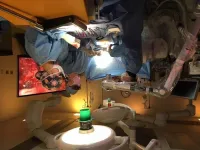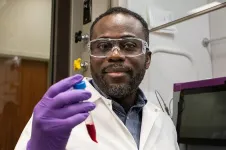(Press-News.org) Mayo Clinic researchers studying the genetics of people who had recently developed dilated cardiomyopathy, one of the most common causes of heart failure, have found a particular gene to target for developing future drug therapy treatments. The disease makes it harder for the heart's left ventricle to pump blood effectively to the rest of the body. In this first genome-wide association study, the researchers sought to understand why some patients get better after developing the condition — and some don't.
"We found genetic variation in the CDCP1 gene, a gene that no one has heard of in cardiology, and its link to improvement in heart function in these patients," says lead author Naveen Pereira, M.D., a Mayo Clinic cardiologist, who studies genetic variation and its implications in diagnosing and treating cardiovascular disease, specifically heart failure.
Genetic variation in the CDCP1 gene can lead to differences in the protein's structure, potentially influencing a person's susceptibility to various diseases or their response to specific therapies.
The researchers identified and examined the role of the CDCP1 gene because of this gene's link to improving the heart's left ventricle to pump blood effectively in people with dilated cardiomyopathy. The CDCP1 gene is often variably expressed in fibroblasts (connective tissue) of people with this condition. In addition, fibrosis (excess fibrous connective tissue in the heart) plays an essential role in the prognosis of this disease.
Dr. Pereira notes interestingly that they also found that genetic variation in or near CDCP1 was significantly associated with death due to heart failure.
They also noted that decreasing this gene’s expression in cardiac connective tissue significantly decreased cardiac fibroblast proliferation and downregulated the IL1RL1 gene. This gene encodes one of the most important heart failure biomarkers, sST2. High levels of this biomarker are associated with fibrosis and death; a decrease in CDCP1 decreases the expression of this protein. Understanding the regulation of sST2 and its relationship with CDCP1 and fibrosis is essential for developing strategies to mitigate the adverse effects of heart failure.
Dr. Pereira explains that these findings raise the possibility of targeting the CDCP1 gene to decrease cardiac fibrosis, which may improve heart function. The study, therefore, has implications for developing new drug therapies for dilated cardiomyopathy and potentially other conditions affected by fibrosis.
According to a report from the American Heart Association, heart failure is an increasingly common diagnosis in the U.S., with a projection of affecting over 8 million people by 2030, an increase of 46% from the present day.
Between 30% and 40% of heart failure cases are due to dilated cardiomyopathy.
"It is the most common cause of a person needing a heart transplant," says Dr. Pereira. “A key indicator of whether patients with dilated cardiomyopathy will recover is whether they have cardiac fibrosis.”
Based on these preliminary findings, the Mayo researchers are doing further animal studies to understand the effect of CDCP1 on heart failure. They are developing molecules to assess their therapeutic potential for dilated cardiomyopathy and heart failure.
"By continuing with this research that started with a human population that we took to the molecular and now animal laboratory, we hope to find new avenues for treatments to take back to the human population we studied, to improve patients' survival and quality of life ultimately," says Dr. Pereira.
Funding
The Mayo Clinic Department of Cardiovascular Medicine and Center for Individualized Medicine funded the study. Review the study for a complete list of authors, disclosures and funding.
This article first appeared on the Individualized Medicine blog.
END
Mayo Clinic study explores heart failure, uncovers gene’s role in recovery
2024-01-24
ELSE PRESS RELEASES FROM THIS DATE:
How studying defensive bacteria may help human gut health
2024-01-24
MSU has a satellite uplink/LTN TV studio and Comrex line for radio interviews upon request.
Images
EAST LANSING, Mich. – Thousands of types of bacteria live in the human gut. They help digest the food we eat and absorb nutrients, but these bacteria don’t just do this to be kind to humans, there is a benefit for them too.
Elizabeth Heath-Heckman, an assistant professor in the College of Natural Science, has received a five-year National Institutes of Health grant from the National Institute for General Medical Sciences totaling $1.9 million to support her research studying ...
Study: This protein may be the ‘glue’ that helps COVID virus stick
2024-01-24
When SARS-CoV-2 enters the human body, the virus’ spike protein binds to a cell, allowing the virus to infiltrate and begin replicating.
A new study from Tulane University, conducted in partnership with Florida International University and published in Protein Science, has identified a protein that may be the glue that helps COVID’s spike protein stick.
The study found that a small piece of a proteoglycan called perlecan LG3 – a protein most commonly found in blood vessels and the brain – ...
Can we predict when a migraine attack will occur?
2024-01-24
EMBARGOED FOR RELEASE UNTIL 4 P.M. ET, WEDNESDAY, JANUARY 24, 2024
MINNEAPOLIS – Migraine is often underdiagnosed and untreated, and even when it is treated, it can be difficult to treat early enough as well as find strategies to prevent attacks. A new study looks at ways to more accurately predict when a migraine will occur—through the use of mobile apps to track sleep, energy, emotions and stress—to enhance the ability to prevent attacks. The study is published in the January 24, 2024, online issue of Neurology®, the medical journal of ...
Researchers suggest changing gold standard of spine surgery from operative microscope to 3D exoscope
2024-01-24
While surgeons have more commonly used the exoscope in various intracranial procedures, its use in spinal surgery has been underreported.
Researchers and neurosurgeons at the Medical University of South Carolina (MUSC) retrospectively compared the operative microscope to the 3D exoscope in a recent study published in World Neurosurgery and found better outcomes among both surgeons and patients when using the exoscope.
Stephen Kalhorn, M.D., FAANS, was the principal investigator on the study, and he says the traditional operative microscope has ...
ORNL wins five Federal Laboratory Consortium awards
2024-01-24
Researchers, staff members and licensees from the Department of Energy’s Oak Ridge National Laboratory received top honors in the Federal Laboratory Consortium’s annual awards competition for excellence in technology transfer, excellence in technology transfer innovation, outstanding researcher and regional technology transfer.
The Federal Laboratory Consortium, or FLC, recently announced 32 award winners, ORNL included, for contributions to technology transfer, which turns cutting-edge research into impactful products and services. The FLC represents more than 300 federal laboratories, agencies and research centers ...
Foodborne-pathogen Listeria may hide from sanitizers in biofilms
2024-01-24
UNIVERSITY PARK, Pa. — An estimated 1,600 people in the U.S. contract a serious infection from Listeria bacteria in food each year and, of those individuals, about 260 people die, according to the Centers for Disease Control and Prevention. Penn State researchers may now better understand how the bacteria, called Listeria monocytogenes, survive and persist in fruit-packing plants by evading and surviving sanitizers.
According to their study, which is now available online and will be published in the June issue of the journal Biofilm, biofilms — comprising otherwise harmless microorganisms that attach to each ...
Purdue Innovates awards Purdue researchers $150K to develop innovations for the marketplace
2024-01-24
WEST LAFAYETTE, Ind. – Four researchers in Purdue University’s colleges of Engineering and Science, the Purdue Institute for Cancer Research and the Purdue Institute for Drug Discovery have received a total of $150,000 from the Trask Innovation Fund to strengthen the appeal of their patent-pending intellectual property for commercial use.
The fund is managed by the Purdue Innovates Incubator, which provides programming for the Purdue University community to ideate, refine and support their solutions. The fund awards up to $50,000 for short-term projects that enhance the commercial value of Purdue intellectual ...
JMIR Bioinformatics and Biotechnology invites submissions for research papers on machine learning-driven genomic predictive models
2024-01-24
JMIR Publications is pleased to announce a new theme issue titled “Machine Learning-Based Predictive Models Using Genomic Data” in JMIR Bioinformatics and Biotechnology. The peer-reviewed journal is indexed in SCOPUS and focused on research in bioinformatics, computational biology, and biotechnology. This new theme issue aims to explore cutting-edge research at the intersection of machine learning and genomics, fostering advancements in predictive modeling for biological insights.
JMIR Bioinformatics and Biotechnology welcomes contributions from global researchers, educators, and practitioners. We encourage submissions exploring diverse aspects of bioinformatics ...
Humpback whales move daytime singing offshore, research reveals
2024-01-24
Humpback whale singing dominates the marine soundscape during winter months off Maui. However, despite decades of research, many questions regarding humpback whale behavior and song remain unanswered. New research revealed a daily pattern wherein whales move their singing away from shore throughout the day and return to the nearshore in the evening. The findings were led by the University of Hawaiʻi, in partnership with NOAA’s Hawaiian Islands Humpback Whale National Marine Sanctuary, and published in Royal Society Open Science.
“Singers may be attempting to reduce the chances of their song being drowned ...
New oviraptor dinosaur from the US Hell Creek Formation lived at the end of the Age of Dinosaurs and weighed about the same as an average woman
2024-01-24
New oviraptor dinosaur from the US Hell Creek Formation lived at the end of the Age of Dinosaurs and weighed about the same as an average woman
###
Article URL: https://journals.plos.org/plosone/article?id=10.1371/journal.pone.0294901
Article Title: A new oviraptorosaur (Dinosauria: Theropoda) from the end-Maastrichtian Hell Creek Formation of North America
Author Countries: USA, Canada
Funding: Funding for histology processing provided to HNW by Oklahoma State University for Health Sciences. Funding to GFF provided by the Royal Society (Grant NIF\R1\191527) and a Banting Fellowship ...





